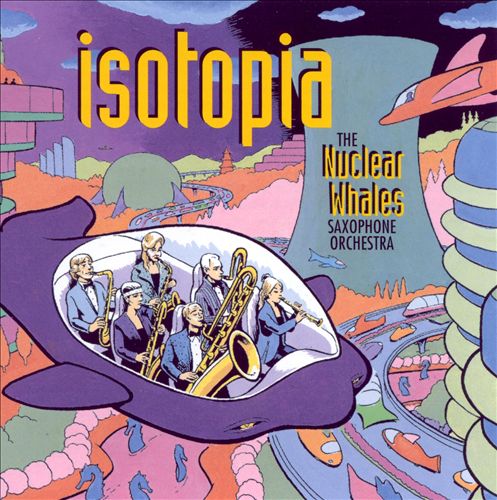It’s been a number of years since the Nuclear Whales Saxophone Orchestra went, well, nuclear, ![]() but those of us who liked their music haven’t forgotten their stellar musicianship. The group was a fabulous ambassador for our instruments—especially the contrabass and bass saxes which were much more uncommon than they are today.
but those of us who liked their music haven’t forgotten their stellar musicianship. The group was a fabulous ambassador for our instruments—especially the contrabass and bass saxes which were much more uncommon than they are today.
Here’s a great example of what I mean. This arrangement of Bugler’s Holiday features the Nuclear Whales’ bass saxophonist doing some amazing things with an 18lb vintage bass. You couldn’t ask for a better ambassador for our bass saxophone…
Yesterday, as I perusing interesting saxophone album covers, I happened across the isotopia album by the Nuclear Whales.
Source: allmusic.com
They really decided to carry the whale/nuclear theme to the max with this cartoon representation of the band flying through the cityscape in their glass-bubbled, whale plane. Having grown up watching Saturday morning cartoons, this album cover is strangely reminiscent of the Jetsons…
Source: afflictor.com
Another Nuclear Whales Saxophone Orchestra album cover along the same lines was the Fathom This: A Retrospective.
Source: freecodesource.com
Although not outwardly futuristic, this album cover I would argue is post-nuclear apocalyptic. The underwater jazz club depicted on it is filled with the now-world ruling sea creatures dancing, and enjoying their saxophone music over martinis and highballs. Ah yes, just the natural evolution after the human race has destroyed itself, and all that’s left of us is our saxophones.
What’s this, you say I’m overthinking it? OK, maybe I am. Maybe this is just a goofy cartoon, meant to be nothing more than a silly album cover for the Nuclear Whales. I’ll give you that, but you have to admit that my interpretation of it has a certain amount of appeal.
Let’s face it, Planet of the Apes has been a popular pop culture phenomena for decades now. Who’s to say that Planet of the Sea Creatures couldn’t be just as viable a Sci-Fi hit. ![]()






For shaniagians my favorite quartet is Sax-O-Matic I don’t know how active they are I haven’t found anything new in a while but they do put on a good show.
http://www.youtube.com/channel/UCAsiWter1L7fDc2ceUaeOaA
The shenanigans of “Bugler’s Holiday” remind me of a group, similar in concept if not instrumentation, that does still exist: Mnozil Brass. You may like what they’re about.
https://www.youtube.com/watch?v=NJTIJRoEWPE
I attended a free concert in Carondelet Park in South St Louis, probably in the late ’90s, at which the Park’s volunteer wind ensemble opened for the Whales in threatening weather. The Whales had strutted onto the barely covered stage for eight bars of their opening number (Take the A Train?) when the skies opened and they hastily repacked their instruments. Drenched anyway, I stood upfront to thank them for coming and found Don Stevens drawing the group’s attention to this strange two-legged aqueous creature so far from the sea. I never got to hear them in person again.
It’s really a shame that the group split up. I never heard a reason for their break-up. They were the first saxophone ensemble that didn’t sound so predictably like a saxophone ensemble that I didn’t get bored of listening to them.
That, for me, is the biggest turn off when it comes to sax-only bands. I haven’t quite figured out if it’s the arrangements; the voicing; or something else altogether, but the sound of most sax ensembles will have me running for the hills. I don’t like to admit it, but it’s true. As much as I might like to play the music, I don’t like listening to others play it.
That’s why I like the bass sax quartet from Germany, Deep Schrott so much. Like the Nuclear Whales, they challenge the conventions of what a saxophone quartet sounds like.
The more people you have, or the more exotic the line-up of instruments, the more “different” the sound is going to be. Aside from groups using synthesizers to do everything, you’re at the mercy of how many different things each person can do.
One way around this is the pit orchestra, where everyone is expected to cover multiple instruments — and not always ones you’d associate with doubling. I remember the pit for “The Black Rider”. That one called for the leader to play keyboards, electric guitar, pocket trumpet (yes it actually says pocket trumpet in the score, not just trumpet), and I believe, musical saw. The musical saw part might belong to another player though. In the production I attended, they actually put him on stage under a spotlight for his solo.
The other way around is to have enough people to do tricks with the voicing. Six, like Nuclear Whales, is just about the minimum you can use to achieve the “antiphonal choir” effect, breaking the group into two trios doing separate things at the same time. It also allows changes of tone color by simply having someone lay out, and inverting parts so that higher voices are tucked inside the chord.
I just finished a render of my own newest sextet (plus percussion) project, Night on Bald Mountain. I don’t call for a contrabass, though sometimes I wish I could. People have complained about the “impracticality” of calling for a bass and a sopranino as it is. Since I do call for two percussionists, I suppose this also helps avoid the pitfall of all sounding the same.
https://mal-2.bandcamp.com/track/night-on-bald-mountain
This one should appeal to you, it’s very October-y, and also rather heavy on the bass sax.
This ensemble with a nino includes bas-sax and tubax:
https://www.youtube.com/watch?v=PghHlMKsEfU
I like the pig like noises by Deep Schrott.
These sounds are not often enough used.
Some exceptions; the Nuclear Whales, Breuker collectief, Collin Stetson, Artvark and some more.
Here are some industrial/classic mixed sounds of Artvark: